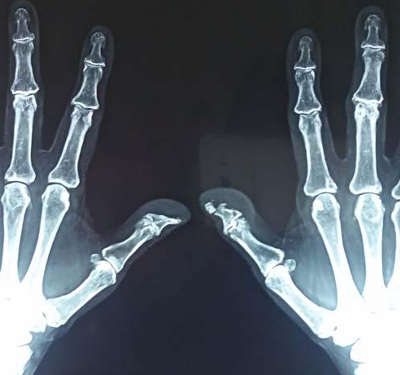Healthy nails, healthy bones
A rare infection of the thumb bone highlights the importance of healthy nail care regimens.
Published online 30 April 2016

Minor repetitive unnoticed trauma to the nail unit has been implicated as a possible source of infection leading to osteomyelitis.
© QScience Connect
Orthopaedists in India have described the rare case of a 65-year-old woman with infection in the bones of both her thumbs, publishing their findings in the journal QScience Connect1. This kind of bone infection, known as osteomyelitis, is very rare in the short bones of the body, such as the finger bones, because they are less prone to trauma than longer bones. Also, their relatively modest blood supply means they are less exposed to infective agents travelling in the blood. As far as the paper’s authors are aware, this is the first case to be reported in the literature of osteomyelitis present in the finger bones of both hands.
The patient had pain and swelling in both thumbs, which had been ongoing for one year. Both her thumb nails were deformed, a condition called onychodystrophy. Nail deformity is relatively common and often happens as a result of persistent nail biting or as an allergic reaction to cosmetics or household cleaning products. In this particular case, the patient had been applying nail polish to her thumbs only for the past two years.
X-rays revealed bone infection in both thumbs, with pieces of dead bone — called sequestra — found in one hand and areas of destroyed bone in the other. The doctors removed the damaged nail and bone tissue, drained both thumbs of accumulating pus, and gave the patient a course of antibiotics. The wound completely healed within three months.
“Minor trauma to the nails and soft tissue pulp of the fingers is inevitable. But it can sometimes lead to bacterial infection of the nail bed,” says Santosh Banshelkikar from Mumbai’s Lokmanya Tilak Municipal Medical College and General Hospital. “This case report underlines the importance of recognizing and treating infection before it spreads to bones,” he explains.
Banshelkikar says healthcare professionals should have X-rays done in cases of nail bed infections when there’s the slightest suspicion of potential bone involvement to detect it early. Early intervention is necessary in these cases to prevent bone destruction from osteomyelitis.
More research is necessary to further understand onychodystrophy and how it occurs, says Banshelkikar. This will help researchers treat onychodystrophy before bone involvement occurs, he says.
References
- Banshelkikar, S. N., Sheth, B. A. & Goregaonkar, A. B. Distal phalangeal osteomyelitis of bilateral thumbs secondary to onychodystrophy - a case report with review of literature. QScience Connect 2016, 1 (2016). | article
DOI: 10.1038/qsh.2016.109

